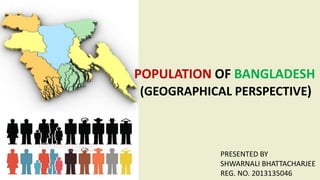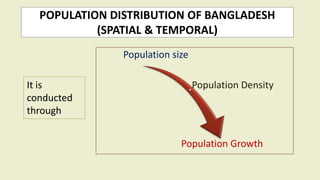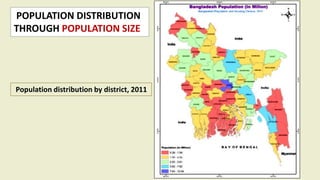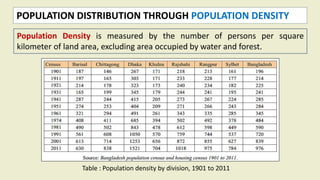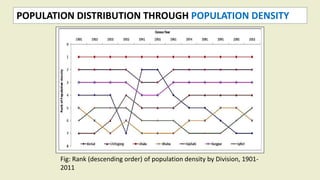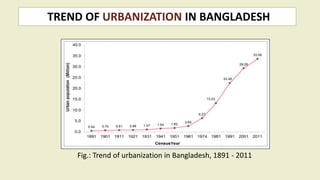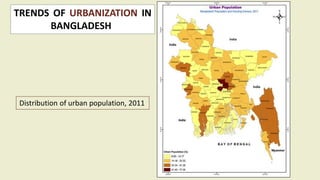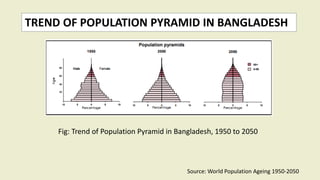Population of Bangladesh
- 1. POPULATION OF BANGLADESH (GEOGRAPHICAL PERSPECTIVE) PRESENTED BY SHWARNALI BHATTACHARJEE REG. NO. 2013135046
- 2. CONTENT ? What is Population ? Present chacrteristics of population in Bangladesh ? Population distribution of Bangladesh ? Trend of Fertility Rate in Bangladesh ? Trend of Mortality Rate in Bangladesh ? Trend of Migration in Bangladesh ? Trend of sex ratio of population in Bangladesh ? Trend of urbanization of Bangladesh ? Population Pyramid and itĄŊs trend ? Population forecast of Bangladesh
- 3. WHAT IS POPULATION? The total number of people inhabiting in a specific area or the number of people in a geographic area.
- 4. PRESENT CHACRTERISTICS OF POPULATION IN BANGLADESH ? Current population - 165,188,241 ? 2.18% of the total world population ? 8th in the list of countries by population ? Population density: 1265 per Km2 ? 35.7 % of the population is urban ? Population growth rate: 1.15% ? Crude Birth Rate: 18.775 births/thousand ? Crude Death Rate: 5.265 deaths/thousand ? Crude Net Migration Rate : -1.948 people/thousand ? Life expectancy (both sexes): 72.709 years ? Total Fertility Rate: 2.086 children/woman ? Infant Mortality Rate: 26.087 deaths/ 1,000 live births Source: World Population Prospectus: The 2017 Revision
- 6. POPULATION DISTRIBUTION OF BANGLADESH (SPATIAL & TEMPORAL) It is conducted through Population size Population Density Population Growth
- 7. POPULATION DISTRIBUTION THROUGH POPULATION SIZE Population distribution, 1901 ĻC 2011 Source: Bangladesh population census and housing census 1901 to 2011 Total Population: 144.04 M Male: 72.11 M Female: 71.93 M Rural Population: 76.7% Urban Population: 23.3%
- 8. POPULATION DISTRIBUTION THROUGH POPULATION SIZE Table: Population distribution by divisions with ranks, 1901 - 2011
- 9. Fig: Population distribution by division in percent, 1901 ĻC 2011 POPULATION DISTRIBUTION THROUGH POPULATION SIZE
- 10. Population distribution by district, 2011 POPULATION DISTRIBUTION THROUGH POPULATION SIZE
- 11. POPULATION DISTRIBUTION THROUGH POPULATION DENSITY Population Density is measured by the number of persons per square kilometer of land area, excluding area occupied by water and forest. Table : Population density by division, 1901 to 2011
- 12. POPULATION DISTRIBUTION THROUGH POPULATION DENSITY Fig: Rank (descending order) of population density by Division, 1901- 2011
- 13. POPULATION DISTRIBUTION THROUGH POPULATION DENSITY Map : Population density by district, 2011
- 14. POPULATION DISTRIBUTION THROUGH POPULATION GROWTH Fig: Average annual population growth rate (Exponential), 1901 ĻC 2011
- 15. POPULATION DISTRIBUTION THROUGH POPULATION GROWTH Table: Average annual population growth (Exponential), 1901 ĻC 2011
- 16. TREND OF FERTILITY RATE IN BANGLADESH TotalFertilityRate YEAR Fig: Trend of fertility rate in Bangladesh, 1960-2015 Source: World Bank Group
- 17. TREND OF MORTALITY RATE IN BANGLADESH Fig: Trends in Under Five and Neonatal Mortality 1994-2014
- 18. Fig: Distribution migration in Bangladesh by division Source: Population Distribution and Internal Migration, vol.6 TREND OF MIGRATION IN BANGLADESH
- 19. TREND OF SEX RATIO OF POPULATION IN BANGLADESH Table : Sex-Ratio for Population of Bangladesh, 1911-2011 Figure : Sex Ratio in Different Census Years
- 20. TREND OF URBANIZATION IN BANGLADESH Fig.: Trend of urbanization in Bangladesh, 1891 - 2011
- 21. TRENDS OF URBANIZATION IN BANGLADESH Fig: Distribution of urbanization by division, 1961-2011
- 22. TRENDS OF URBANIZATION IN BANGLADESH Distribution of urban population, 2011
- 23. Fig: Population Pyramid (estimated 2017) Source: Population pyramid .net POPULATION PYRAMID IN BANGLADESH
- 24. TREND OF POPULATION PYRAMID IN BANGLADESH Fig: Trend of Population Pyramid in Bangladesh, 1950 to 2050 Source: World Population Ageing 1950-2050
- 25. POPULATION FORECAST OF BANGLADESH Figure : Population growth (in % annually) for the past as well as the future up to 2050 Source: UN, World Population Prospects, the 2012 Revision: Volume II: Demographic Profiles Figure: Population of Bangladesh for the past as well as future up to 2100
- 26. REFERENCES ? Population Monograph: Volume 6, Volume 9 ? World Bank Group ? Populationpyramid. Net ? World Population Ageing 1950-2050 ? wikipedia.org ? World Population Prospectus: The 2017 Revision
Editor's Notes
- #18: A neonatal death is defined as a death during the first 28 days of life (0-27 days).
